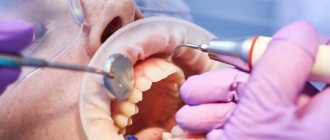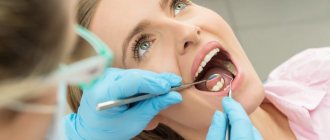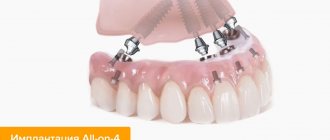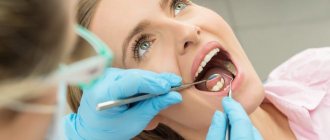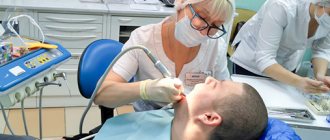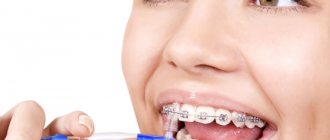The human body can be susceptible to attack by various parasites - this has long been no secret. However, there are sources that like to significantly embellish reality and intimidate people far from science with various horror stories. They say that parasites are gradually eating us from the inside, they live in almost every person, and it’s easy to become infected with them - they are lying around at every step.
And here you go, one of the hottest debates in dentistry: can worms still live in human teeth?
Myths about the toothworm
So, let's turn to history. Ancient Sumerian cuneiform tablets have been found on which an unknown author reproaches the gods for the appearance of tooth-eaters. The worm was mentioned by Babylonian doctors and healers of Ancient China. The parasite was familiar to scientists of the Arab East, physicians of the pharaohs and Indian shamans.
Greece became the first country where, thanks to Hippocrates, the doctrine of a worm in a person’s teeth was transferred to the section of myths. Other cultures continued to believe in this parasite until the 18th century.
They tried to expel the worms in different ways. It was believed that moonlight was fatal to them. Therefore, at night, many sufferers climbed onto the roofs of houses and sat there with their mouths open. Frog fat was also considered a poison for the tooth beetle. Amphibians were mercilessly caught and killed. And as a preventive measure against worm infection, it was proposed to bite off the heads of live bats twice a month. The most adequate way to combat the disease is the use of enemas and laxatives.
In some cases, methods were used to kill parasites that could injure or kill the patient himself. For example, a rotten tooth with worms was poured with acid or hot wax. They also tried to burn it with a hot iron. Bird droppings or poisons were applied.
People endured terrible torture, but they were afraid to remove worm-infested teeth. It was believed that the brain would begin to flow out through the resulting hole. Even Hippocrates was sure that pain originates in the head and then goes down to the tooth. So deleting it won't help. If a tooth is missing, the pain will return to the head.
How to identify a parasite
First, pay attention to how you feel, what specifically causes concern. If you have problems with the intestines, be it constipation or diarrhea, restless sleep, itchy skin, muscle pain, you should consult a doctor. All difficulties with the body in the presence of parasites are associated with the release of toxins by them, which affect the normal functioning of the human body. And restless sleep and grinding teeth are a sign of anxiety, this is how the body talks about the problem. The main method for identifying parasites remains stool analysis. In this case, a distinction is made between a standard analysis and a detailed one, which is used in the medicine of functional disorders. Their main difference is accuracy. A standard test can only detect the parasite if it is alive and active. Then, if the pest has died due to the end of its life cycle, or is hibernating, the standard method will not work. The result will be negative, and you will be sure that you do not have a harmful microorganism, although this will not be the case. There are no such problems with a detailed analysis, since it uses the polymerase chain reaction method. The method allows you to identify the parasite in any state and does not depend on the laboratory assistant’s ability to see the pest under a microscope. Thanks to this approach, patients who received a negative standard test are surprised to learn about unwanted “cohabitants” after PCR, which subsequently allows them to solve the problem with their health.
How can worms get into teeth?
One of the first to discover microorganisms in the oral cavity and dentinal tubules was Antoine Leeuwenhoek. He refuted the tooth-eater theory. One day he was sent several worms, which were allegedly extracted from carious cavities. Leeuwenhoek used a microscope to prove that the resulting samples were identical to the larvae of those insects that live in overripe cheese. The scientist suggested that the person whose tooth was removed ate this product before the procedure. The patient's husband confirmed that she actually ate wormy cheese. Thus, the larvae ended up in carious cavities.
Thanks to the toothworm theory, many charlatans were able to get rich. Until the second half of the 19th century, Chinese healers operated in Moscow. They used hollow wooden hooks, inside which cabbage worms were previously placed. When a person with a toothache came to the healers, they picked their teeth with this tool for several minutes, then removed the worm and showed it to the amazed patient.
It has long been proven that it is not worms in teeth that cause the development of caries. However, parasites can enter the human mouth. These can be either tiny protozoa or real worms.
Oral amoeba
No worms were found in the teeth of patients who sought dental care due to caries. But in 95% of patients, a protozoan called oral amoeba is present in the oral cavity. Its Latin name is Entamoeba gingivalis. It is most often found in tartar, gum pockets and alveoli.
This creature is not a pathogen and does not cause harm to its owner. Although there are scientists who are of the opinion that amoeba is capable of mutating and causing inflammation of the central nervous system.
Entamoeba gingivalis enters the oral cavity through unboiled water, unwashed fruits and vegetables, as well as through a kiss or someone else's toothbrush.
The amoeba feeds on bacteria that form plaque and tartar. If your gums are bleeding, Entamoeba gingivalis can trap red blood cells.
You can get rid of the parasite if you maintain oral hygiene and seek dental care on time. You should also wash all fruits and vegetables before eating and use only clean drinking water.
Who lives in the oral cavity
Various bacteria, as well as protozoan microorganisms and helminths, can live in the oral cavity. Their food is not leftover food, but substances that are beneficial to the human body that come with food, as well as epithelial cells.
Trichomonas
Of all the groups of protozoa that can infect the human body, oral Trichomonas is the least studied. Doctors believe that infection with Trichomonas has a negative effect on the teeth and oral mucosa. Protozoa often lead to widespread diseases in the mouth and respiratory system.
The structure of Trichomonas oral is similar to that of the intestines. It has a membrane, flagella, and a pear-shaped body with four strands at the anterior end. The membrane is located on the side, reaching a quarter of the length of the body. This organ, together with flagella, is used as a means of movement along mucous membranes.
Trichomonas are isolated from the sputum of patients with pathologies of the bronchopulmonary system. Doctors are of the opinion that protozoa from the oral cavity easily enter the lungs, nasopharynx, and sinuses, thereby leading to the active spread of infection.
Trichomonas do not reproduce by cysts, but only vegetatively, so they can penetrate the human body. You can only become infected through contact, since microorganisms cannot live in the external environment.
The mouth group secretes substances similar to the cells of the human body. This allows them to camouflage themselves from the immune system.
Oral amoeba
In addition to Trichomonas of the oral cavity, amoeba can live there. It also belongs to the protozoa. Both microorganisms are human commensals, that is, they enter into symbiosis with the host. Protozoa receive special benefits from such a process, but humans receive neither benefit nor harm.
Amoeba usually settles on the crypts of the tonsils of the palate, in dental plaque, in sputum or gums. For nutrition and life, it requires leukocytes, red blood cells or those bacteria that live in the mouth.
Amoeba does not form cysts and is transmitted through contact, for example, through a kiss or when sharing dishes, during sneezing, coughing.
Oral myiases
Oral myiases are diseases that develop as a result of insect larvae entering the oral cavity. Myiasis is characterized by a severe course, and the causative agents are usually fly larvae that have entered the oral mucosa from food or hands.
Myiasis is not a common pathology, but we should not forget about the existence of such a dangerous disease, and also study the risk groups that include children. Typically, parasitic diseases are common in areas where hygiene standards are not well observed.
If the larva manages to penetrate the brain, then death occurs. It is myiases that are the cause of scary stories and legends about worms.
The most dangerous are nematodes that enter the mouth while swimming in open water. They affect the cheeks, larynx, tonsils, leading to unbearable toothache and discomfort, sensations of movement in the tooth.
Trichomonas
Oral Trichomonas is uncommon and is considered the least dangerous of all. Nevertheless, it must be disposed of in a timely manner to avoid possible negative consequences.
You can become infected with Trichomonas in the following ways:
- Using contaminated lip cosmetics or accessories to apply them.
- Through a sick person's toothbrush.
- Through poorly washed, contaminated spoons and forks.
The likelihood of infection increases if there is a violation of the integrity of the oral mucosa. For a long time, the disease can proceed hidden. Trichomonas does not correspond to the classical idea of worms in teeth, but is a parasitic organism that lives in the oral cavity and can cause the development of such pathologies:
- Purulent inflammation of the gums.
- Formation of ulcers and erosions on the mucous membrane.
- Curdled coating on the tongue.
- Swelling, itching and burning of the inner surface of the cheeks.
- Bad breath.
Adequate treatment should be prescribed by a doctor after diagnosis. The most commonly used drug is Trichopolum.
Symptoms
Any parasites that enter the human body form pathogenic microflora and provoke certain symptoms in accordance with the type and extent of the lesion. Common signs of parasitic infestation include:
- allergies,
- a sharp deterioration in health due to the ingestion of many toxins produced by worms and protozoa,
- causeless weight loss,
- constant nausea
- weakness.
Worms living in the mouth often aggravate existing diseases, leading to tooth decay, suppuration on the mucous membranes of the mouth and tongue. The most common and active symptom of infection is bad breath, accompanied by itching of the larynx and a feeling of movement in the tissues of the pharynx.
Sarcocystosis
You can become infected with sarcocystosis if you eat raw or undercooked thermally contaminated meat. Most often, a person suffers from the intestinal form of the disease. But more dangerous muscle infections can also occur.
Any muscle can be infected, including the chewing muscles. If this happens, the patient will begin to develop characteristic ulcerations on the gums, lips and mucous membrane of the soft palate. The lymph nodes will enlarge. The extracted parasites fully correspond to the ancient ideas about worms in human teeth. The photo of the sarcocyst confirms this. The exception is that they do not live in the teeth, but in the esophagus, gums or lips.
Gongylonematosis
A nematode can live under the oral mucosa. It is possible that in the past, it was he who was blamed for the development of caries and was mistaken for a worm in the tooth causing terrible pain. We will not attach a photo of this microorganism for aesthetic reasons, but the size of this monster is amazing; its length can reach 145 mm. The causative agent of the disease is the nematode Gongylonema pulchrum.
Infection can occur through accidental ingestion of a cockroach or dung beetle. And also with food or water contaminated with larvae.
At first, the disease is disguised as pharyngitis or stomatitis. Then zigzag passages and abrasions begin to appear on the oral mucosa, the gums become red and swollen. Papules appear, making it difficult to move the tongue. Gradually, the patient develops intoxication. The parasite can only be removed surgically.
Treatment options
The required treatment method is prescribed by the doctor after receiving the test result. The course of prescribed medications depends on what specific parasite is detected in you, because what destroys one pest will not affect another at all. However, there are cases when it is not possible to identify a harmful microorganism, then the doctor prescribes mixtures of different herbs. Most often it is magnesia, tribulus extract, barberry and grapefruit extract, annual wormwood infusion, walnut extract and bearberry extract. All these ingredients are sold in pharmacies. The mixtures work by creating bacteria that are beneficial to the intestines, which actually fight microorganisms that are harmful to us. If you had liver disease, or you abused alcohol, check this point with your doctor; perhaps you should not use herbs, or you will need to reduce the frequency and number of doses. Remember, most parasites can be identified and treated. Get examined in a timely manner, follow all the instructions of your doctor, and your health is guaranteed!
Oral myiasis
In countries with hot climates, real worms can settle in the gums. Deposits in teeth, wounds, ulcers, and irregular brushing contribute to rapid infection.
Some types of parasitic flies manage to lay eggs on the skin when they bite a person. Thanks to the warmth, they begin to ripen. The hatched larva tries to get to the area where the skin is as thin as possible or damaged. When a suitable place is found, it bites inside, where it grows and feeds. In the mouth, they are able to live in the gums, lips, cheeks and even the roof of the mouth.
The number of larvae can reach 300 pieces at a time. They can cause serious bleeding. Normal chewing of food causes unbearable pain to the patient. A person feels a twitching inside the gums. Bleeding ulcers gradually increase in size and emit an unpleasant odor. The patient becomes more lethargic and his body temperature rises. Even deaths have been recorded, as the larvae are able to migrate to other organs and damage them.
Prevention of parasites and mandatory medical preventive control
All of the listed pathologies are not so common in domestic dental practice. During consultations, dentists always warn patients that regular and proper brushing of teeth, as well as timely examinations, will help minimize the possibility of developing diseases. In order to never encounter worms in your teeth, you should follow these recommendations:
- Consult a doctor immediately if you are concerned about swelling or pain in your gums or lips.
- Do not eat meat and fish of questionable quality.
- Rinse fruits, vegetables and herbs thoroughly.
- Get rid of flies as soon as possible after they fly into the room. Do not eat foods that insects have sat on.
- Always maintain good oral hygiene.
- Do not use someone else's toothbrush, lipstick or lip brush.
- Always wash your hands, especially after visiting medical facilities and other public places.
If you follow all the recommendations listed, you can easily avoid exposure to oral parasites. In the event that, after visiting some exotic country, you feel as if something is moving in your gums, modern medicine can quickly cope with this problem.
4.Treatment
In the most severe cases (see above), urgent or emergency surgical intervention is necessary for life-saving reasons. In other situations, etiotropic treatment is carried out with anthelmintic drugs (self-medication is strictly excluded!), the spectrum of which at this stage is very wide, the action is selective and targeted, and side effects are minimized - which makes it possible to successfully and radically expel almost any helminth from the body. Important tasks, however, remain the exclusion of reinvasion (for this purpose, in some cases, examination and treatment of the entire family is prescribed with simultaneous sanitization of living conditions), as well as somatic and immune rehabilitation of the patient.
